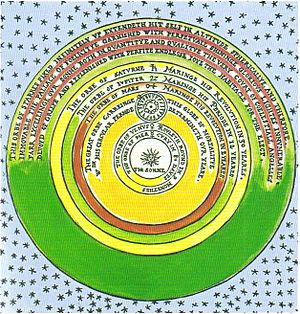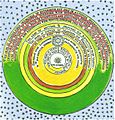Thomas Digges facts for kids
Quick facts for kids
Thomas Digges
|
|
|---|---|
| Born | c. 1546 Wootton, Kent, England
|
| Died | 24 August 1595 London, England
|
| Nationality | English |
| Known for | Proposing that the universe is infinite in extent |
| Scientific career | |
| Fields | Astronomer and mathematician |
| Academic advisors | John Dee |
| Notes | |
|
Son of Leonard Digges, and father of Dudley Digges and Leonard Digges (II)
|
|
Thomas Digges (born around 1546 – died August 24, 1595) was a smart English mathematician and astronomer. He was the first person to explain the Copernican system in English. This system showed that the Earth and other planets orbit the Sun, not the other way around.
Digges also had a big idea about the stars. He believed there were countless stars spread out across endless space. This was different from the old idea that stars were fixed on a giant, unmoving shell. He was also one of the first to think about the "dark night sky paradox". This paradox asks why the night sky is dark if there are so many stars in an infinite universe.
Contents
Early Life and Education
Thomas Digges was born in Wootton, Kent, England, around 1546. His father was Leonard Digges, a well-known mathematician and surveyor. After his father passed away, Thomas was cared for by John Dee. John Dee was a famous Renaissance scholar who studied many different subjects.
In 1583, a powerful leader named Lord Burghley chose Digges for an important task. Digges, along with other scholars, was asked to decide if England should start using the Gregorian calendar. This new calendar was suggested by John Dee.
Public Service and Military Career
Thomas Digges was also involved in politics and the military. He served as a member of Parliament for the town of Wallingford. This meant he helped make laws for England.
From 1586 to 1594, he worked as a Muster-Master General. This was a military role during a war with the Spanish Netherlands. In this job, he helped improve the Port of Dover, which was important for England's defense.
Thomas Digges passed away on August 24, 1595, in London. He was buried in a church called St Mary Aldermanbury.
Family Life
Thomas Digges married Anne St Leger. They had two sons who survived, Sir Dudley Digges and Leonard Digges. Dudley became a politician, and Leonard became a poet. They also had two daughters, Margaret and Ursula.
After Thomas Digges died, his wife Anne married again. Her second husband was Thomas Russell. This Thomas Russell was later named by William Shakespeare as someone to help manage his will.
Astronomical Discoveries
Thomas Digges made important observations about the sky. In 1572, a very bright new star, called a supernova, appeared in the sky. Tycho Brahe, another famous astronomer, also observed it.
Digges tried to measure how far away this supernova was. He realized it had to be much farther away than the Moon. This was a big deal because it went against the old ideas of Aristotle. Aristotle believed that the stars were fixed and never changed.
Explaining the Copernican System
In 1576, Digges published a new version of his father's book, A Prognostication everlasting. Thomas added new parts to this book. The most important part was called A Perfit Description of the Caelestiall Orbes.
This new section explained the Copernican model of the Universe. This model said that the Sun is at the center, and the Earth and other planets orbit around it. This was the first time the Copernican model was published in English. It helped many more people learn about this new way of understanding the Universe.
The Infinite Universe
Thomas Digges went even further than Copernicus with his ideas. He suggested that the Universe is infinite. This means it goes on forever and has countless stars. He might have been the first person to propose this idea.
Before Digges, people thought the stars were all on a single, fixed sphere. Digges imagined the stars scattered throughout endless space. This was a huge step in how people thought about the size and nature of our Universe. He believed this endless space was "the palace of felicity garnished with perpetual shining glorious lights innumerable."
Images for kids



